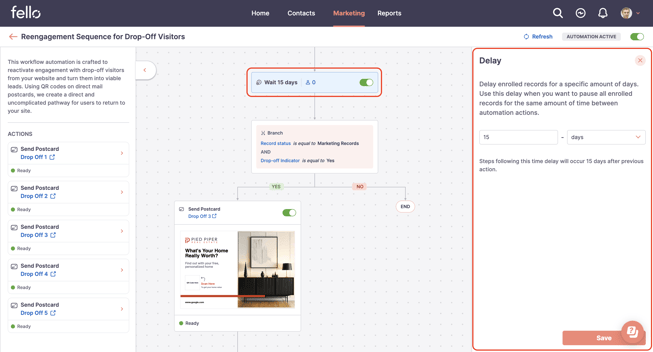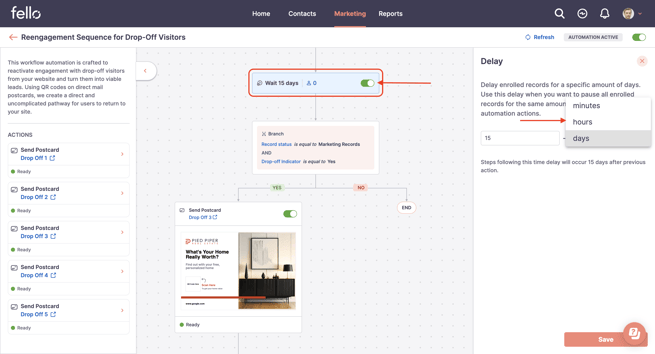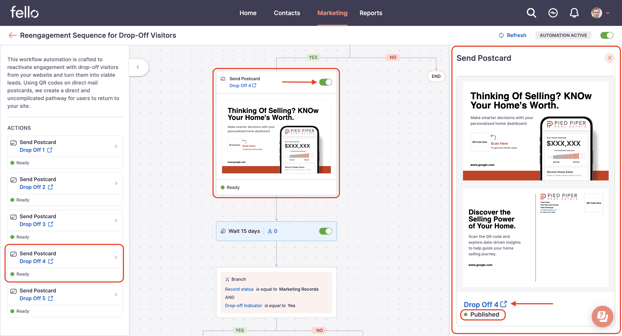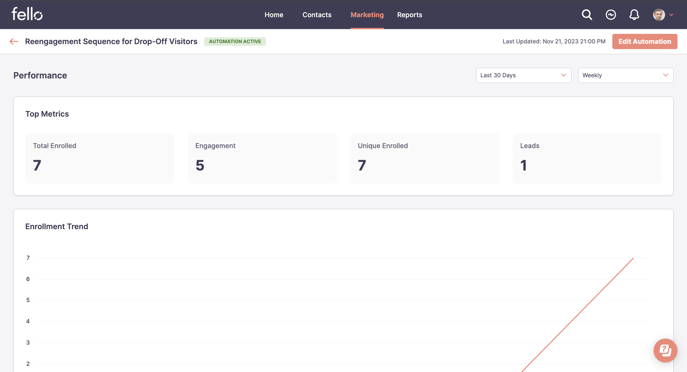Fello Automations: A Simplified Guide for Real Estate Teams
How Fello Automations enhance real estate marketing through customizable, efficient automations for email, postcard sending, and performance tracking.
Introduction:
Turn on automations to enable automated marketing to contacts and make your team more efficient. In Fello, you will get pre-defined automations specific to marketing use cases and you can add additional conditions for enrolment or branch criteria, review there marketing content and make specific edits and turn off specific actions if you feel they are not necessary.
Value Proposition:
Data-Driven Automations:
Fello's Automations are built on a foundation of data-driven insights, ensuring that every marketing action is informed by relevant data. This approach enables the system to determine optimal timelines for each automation and set precise enrollment criteria. By leveraging real-time data, Fello ensures that your marketing efforts target the right individuals at the right time, enhancing efficiency and effectiveness.
Intelligent Enrollment Criteria:
At the heart of Fello's Automations is the smart utilization of data to define who gets enrolled in each marketing campaign. This means your automations are tailored to engage only those contacts most likely to respond positively, thereby maximizing your marketing ROI while minimizing unnecessary expenditure.
Customized Client Engagement
While Fello provides a suite of pre-built automations, the platform also empowers you to customize these automations based on data-driven insights. You can adjust the enrollment triggers, timelines, and content based on analytics, ensuring that your marketing communications are both relevant and timely.
Data-Driven Decision Making
Fello doesn’t just automate your tasks; it provides valuable insights into your marketing campaigns. Track the performance of each automation, understand client engagement through detailed metrics, and adjust your strategies based on real-time data. This data-driven approach helps you refine your marketing efforts for maximum impact.
Flexibility and Control
The flexibility of Fello Automations puts you in control. Easily create, modify, pause, or resume your marketing automations to align with your business goals and market conditions. This level of control ensures that your marketing efforts are always synchronized with your business strategy. And the best part, all automations are pre-built so that teams do not need to spend time on crafting automations from the scratch.
Efficient Time Management and Increased Productivity:
With pre-built and customizable automations, real estate teams can save considerable time and effort that would otherwise be spent on manual marketing tasks. This automation frees up time for agents to focus on high-value activities, such as personal client interactions, property showings, and strategic planning. The result is a more productive team that can handle a larger volume of clients and listings without compromising the quality of service.
Comprehensive Listing
Our Centralized Automation Hub is designed to revolutionize the way your team handles automations, from lead generation to nurturing to farming and beyond. Here's what you can expect:
-
Easy Navigation: We've categorized automations into clear groups like Lead Generation, Lead Nurturing, and Farming. You can navigate to Automations via Marketing>Automations.

-
Dynamic Sorting: Newly added automations take the spotlight, ensuring you're always up-to-date with the latest tools. The list prioritizes available automations, with the newest ones appearing first in each category.
User Feedback and Collaboration
Your input is invaluable:
-
Idea Submission and Voting: Have a great idea? Submit it and let others vote to bring the best ideas to life. Click on Submit Idea button and tell us about your idea, its value proposition and what importance it holds for you.

Components of Automation:
-
Enrollment Criteria(Trigger):
-
Specific conditions that contacts or properties must meet to be enrolled.
-
-
Branch:
-
Determines the flow of automation. Decision trees shaping the flow.
-
-
Delay:
-
Awaiting period before an action is executed. Intervals preceding actions.
-
-
Action:
-
Tasks executed after conditions and delays are met. For marketing automation, it will be send email, send postcard, send letter. Final steps following conditions and delays.
-
Smart Automations:
Fello will have pre built automations set up for users and they can review and publish the automation. First system defined automation will be the Reengagement Sequence for Drop-Off Visitors to target Drop Off Users. System Defined Automations cannot be deleted. They can only be turned on or turned off. Users can add additional conditions to enrollment trigger and branches, change delays, customize content being sent as part of the automation, turn off actions in the automation but they cannot delete the system defined automations.
Components:
A. Enrollment Trigger:
-
You can specify the criteria that contacts need to meet in order to be enrolled (included) in an automation.

Re-Enrollment Criteria:
-
Allow users to add select and deselect re-enrollment trigger conditions
-
If an automation was previously enrolled, exited the automation and does not meet the reenrollment criteria, then it will not be enrolled to the automation
B. Delay:
-
Users can increase or decrease delay days.
-
Delay can be in hours or days
-
Input will be validated to proper input for minutes hours(max 24) and days(max 180)
-
Delays can be turned off by the user
-
User List can be only seen in delay step. Delay step will show the number of users in the delay and clicking on the step will show the detailed list of records in the delay step.


C. Branch:
-
Users can add filter conditions to move records out in addition to the system defined filter condition already present in the branch for system defined automations.

D. Action:
Fello automations currently facilitates actions for sending emails and postcards. While users can deactivate pre-set action steps, the automation must retain at least one active step to function; it is not possible to disable all steps.
-
Email:
-
Users can modify content and CTA button labels.
-
Users can preview changes before saving.
-
All these changes happen in Content section, not in automation page. So, changes to content will affect all Automation linked to the Content.
-
-
Postcard:
-
Users can edit heading, subheading and other postcard text in the front and back of the postcard.
-
Users choose which form to use to link to the QR code.
-
Users can Download Proof to visualize the final output.

-
E. Pause & Resume:
-
You can pause and resume automations by manually turning them on or off. When you turn off an automation, all the currently enrolled contacts will be unenrolled - this means that if you turn it back on later, only contacts that meet the enrollment criteria at that time will be enrolled.

-
If an automation is automatically turned off by the system due to insufficient credits, all records will be paused at the respective step. When the automation is turned on by the user, the paused records at respective steps will be automatically executed based on the automation steps. For new records which have not been enrolled in the automation, you will have 2 options to choose when it is turned back on:
- Enroll All Matching Contacts: All contacts that currently meet the enrollment criteria will be enrolled, along with any future contacts who meet the criteria.
- Enroll Future Contacts Only: Only contacts that meet the criteria in the future won't will be enrolled, while all contacts that currently meet the criteria will not be.
- Enroll All Matching Contacts: All contacts that currently meet the enrollment criteria will be enrolled, along with any future contacts who meet the criteria.
F. Action Retry Mechanism:
-
For failed actions, such as postcard sending due to insufficient credits, system will mark these actions as failed and hold the records at the same step in the automation. When the automation is turned back on, the actions which were paused at the individual steps inside the automation will run from the step and continue to the different paths of the automation.
-
For failed actions, such as postcard sending due to system issues or third party API issues, system will continue to automatically retry the failed steps until they are successful. No manual action is needed from the user standpoint.
G. Performance:
Users can get a snapshot of each automation's core metrics, including:
-
Automation Name
-
Status (Active/Inactive)
-
Total Enrollments
-
Engagement Metrics (e.g., Scans/Clicks)
-
Leads Generated
-
Credits Utilized
-
Last Modified Timestamp and User ID/Name
User can also view reports for Enrolment Trends, Engagement, Leads, Credits Used and Content Performance for each content used in the automation. Users can also click on individual data points of the reports to view detailed list view of the records.


FAQ:
How do I troubleshoot automation errors?
Automation errors are automatically resolved by Fello team. Will my automation automatically turn off in certain situations? Automations will be automatically turned off only when your account is out of credits and credits cannot be auto replenished using auto recharge because of failed payments on the credit card on file. You need to recharge your credits by retrying payment or correct the card number and make the payment. Once the payment is successful and the credits are allocated to your account, you have to go ahead and manually turn on the automation.
What happens when a record is deleted? Deleted records are automatically unenrolled from automations.
Why aren't existing records that meet a automation's enrollment triggers being enrolled in the automation after turning it on? When turning on a automation, under the “Yes, enroll all existing records which meet the enrollment criteria as of now” option, you can choose whether or not to enroll existing records that currently meet the trigger criteria. If this option is set to “No, only enroll records which meet the enrollment criteria after turning the automation on”, then any existing records, will not be enrolled automatically even if they currently meet the criteria. Only records that change to meet the enrollment triggers after the automation is turned on will be enrolled. When you change the enrollment triggers in any active automation, a dialog box will appear for you to choose to immediately enroll any existing records that meet the updated enrollment triggers.
Why aren't previously enrolled records that meet a automation's enrollment triggers again being re-enrolled in the automation?
By default, records are only enrolled in a automation the first time they meet the automation's enrollment triggers or are enrolled manually.
Can I use a list or segment in automation criteria? Currently, you can only add filter conditions on fields. Filter conditions on list or segment is not supported.
How many conditions can I add to enrolment triggers or branch criteria in an automation? There is no limit of user criteria addition to an enrolment
Why are my automation actions not executing at the expected time?
When a large number of records enroll in a automation or execute an action at the same time, the automation may be throttled. When a automation is throttled, actions will not execute immediately, but in a queue as records are processed.
What happens to enrolled records when I add more automation actions?
Adding actions to an active automation can impact records that are enrolled and active in the automation:
-
Any records that haven't yet made it to the new action will be scheduled for it when they reach that action.
-
Any records that have already proceeded past that point will not complete the new action.
What happens to enrolled records when I remove automation actions?
Removing actions from an active automation will not affect records that are currently in the action step. The records which already came to the action step before the action step was deleted was execute the action. New records will not come to the action step after the step is deleted and move to the next step of the automation. The records will proceed to the next step of the automation and continue in the automation.
What happens to records waiting in a automation delay when the delay is turned off?
When you turn off a delay, records waiting in the delay will immediately skip the delay, then proceed through the rest of the automation.
What happens to records waiting in a automation delay when the delay timing is changed?
When you change the length of a delay, the records waiting at the delay will immediately be rescheduled. Rescheduling will take into account the amount of time that has already passed in the original delay.
-
If you make a delay longer, delayed records will be rescheduled to complete the remainder of the new delay length. For example, if you adjust a delay from one hour to two hours, records that have already waited 30 minutes will wait for an additional hour and 30 minutes.
-
If you make a delay shorter, records will be either be rescheduled to the new length, or exit the delay. For example, if you adjust a delay from two hours to one hour, a record that's waited for 30 minutes will wait for an additional 30 minutes. A record that's waited an hour and 30 minutes will exit the delay immediately.
